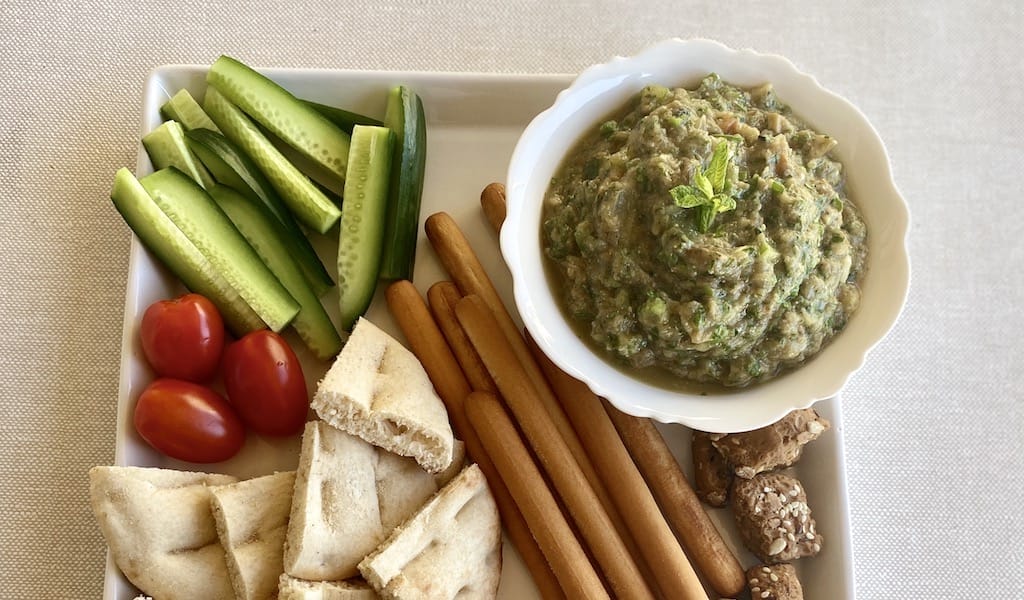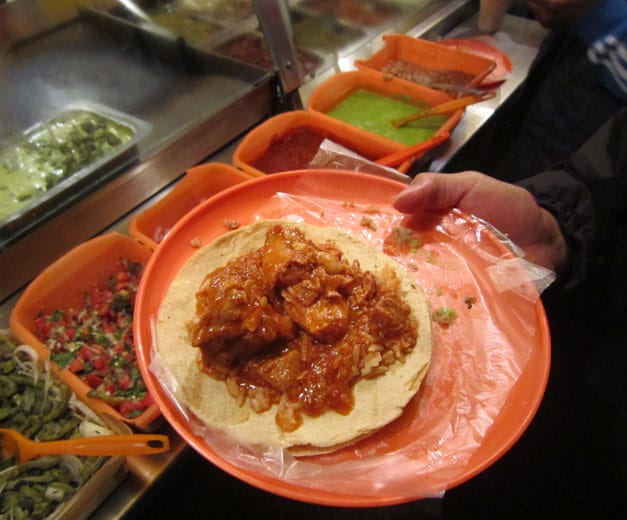These days, plenty of traditional restaurants in Lisbon display in their windows a homemade sign reading “Há Lampreia.” We have lamprey. This simple message is usually illustrated by a pixelated photograph of said creature, almost always taken from Google.
While lamprey, an eel-like fish, is one of the ugliest in mother nature’s portfolio, many people are delighted to look at it. That’s because lamprey, the ingredient, has a lot of fans in Portugal, especially in the areas around the rivers (Minho in the north, and Tejo in the center) where it is usually caught during its spawn migration period, from January to April. It’s also popular in Lisbon, where very experienced northern-born or -influenced cooks know how to prepare and cook it magnificently, letting its meaty flavors and firm – but not too firm – texture shine in every dish.
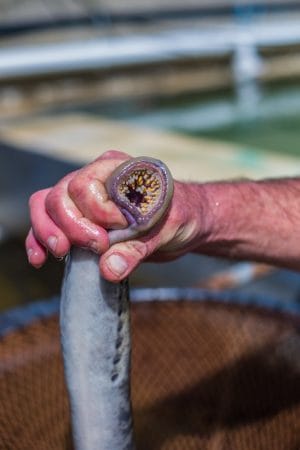 Like hagfishes, lampreys are a special kind of fish, called cyclostomes or agnathans – agnatha is a Greek word that means jawless. They’re believed to be one of the earliest vertebrates, even though they have no bones, only cartilage. Lampreys are also considered parasites because they use their mouth, and its rows of sharp, pointy teeth, to latch on to other fish, from which they suck tissue and fluids. So, not only do they lack the looks, their lifestyle isn’t that glamorous. But they are indeed delicious and have been part of royal menus in Europe for quite a long time – King Henry I, from England, is said to have died from “a surfeit of lampreys” (although most historians believe it was food poisoning) in 1135.
Like hagfishes, lampreys are a special kind of fish, called cyclostomes or agnathans – agnatha is a Greek word that means jawless. They’re believed to be one of the earliest vertebrates, even though they have no bones, only cartilage. Lampreys are also considered parasites because they use their mouth, and its rows of sharp, pointy teeth, to latch on to other fish, from which they suck tissue and fluids. So, not only do they lack the looks, their lifestyle isn’t that glamorous. But they are indeed delicious and have been part of royal menus in Europe for quite a long time – King Henry I, from England, is said to have died from “a surfeit of lampreys” (although most historians believe it was food poisoning) in 1135.
According to food historian Virgílio Nogueiro Gomes, the first reference to lamprey in a Portuguese recipe is in Infanta D. Maria’s (the granddaughter of King D. Manuel I) recipe book, written during the 16th century, where she mentions a lamprey stew with spices. Arte da Cozinha (“Art of Cooking”), written by Domingos Rodrigues in 1680, reveals three recipes for lamprey: roasted, pickled, and boiled. But, for a long time, most places in Portugal have been serving it in one of just two ways: à bordalesa – which means the Bordeaux way – stewed in its blood and red wine and served with fried bread, or à minhota, which is a rice-based dish, with the lamprey’s blood also used in the cooking process.
Preparing lamprey is quite the task. Nuno Diniz, the chef who runs the Culinary Arts course at the Hotel and Tourism School of Lisbon, does an annual voluntary master class on the subject for his students when the fish is in season. He calls it “voluntary” because it is not part of the course curriculum. But most students attend anyway, even if they have no interest in learning how to prepare this specific ingredient – it’s always a pleasure to listen to Diniz speak so passionately. It’s both a practical and theoretical lesson, where he explains, for instance, the importance of rain to help lampreys reach the rivers (they spend much of their lives in salt water before returning to fresh water to spawn, and the more it rains, the more fresh water enters the sea, making it easier for the fish to find their way to the rivers), and also how their price and quality fluctuate during the season.
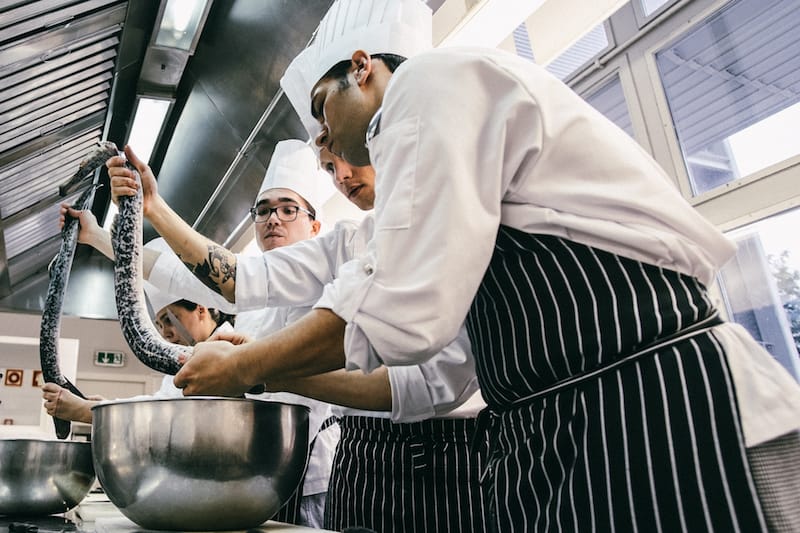
He also teaches the students how to parboil lampreys in order to better remove their skin, and how to take out the stomach and preserve the blood, mixing it with red wine from the Vinho Verde region, in Minho, the one traditionally used for this preparation. In the end, they prepare lamprey pies together, a recipe that Diniz used to serve at his restaurants but one that he now only does once per year, precisely on this occasion, to serve at the school’s test restaurant.
Fortunately, there are some other very good places to try lamprey in Lisbon. Here are a few of our favorites:
Imperial de Campo de Ourique
At this Campo de Ourique classic, Senhor João and his wife, Dona Adelaide, kick off lamprey season as soon as the fish are first caught in their hometown of Ponte da Barca, Minho. Adelaide learned how to prepare it from an aunt and has, over the course of many years, mastered the two customary recipes, à minhota and à bordalesa. It’s mandatory to order a few days in advance.
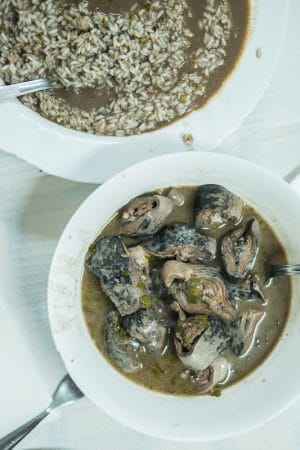 Adega Solar Minhoto
Adega Solar Minhoto
Joaquim Sá and Reinaldo Pinto, the owners of Adega Solar Minhoto, hail from the Minho region (Paredes de Coura and Ponte de Lima, respectively), so it is no surprise that lamprey is a yearly tradition at this tasca in Alvalade. Idalina Sá, Joaquim’s wife, cooks it à minhota – with rice – for groups of at least three people. It is also mandatory to order a few days in advance.
Tasca do João
One could call this small restaurant in Lumiar, a neighborhood in northern Lisbon, the unofficial gastronomic embassy of Minho: As soon as the first lampreys start to appear in the Minho River, at the beginning of each year, Tasca do João has them on the menu. Every portion uses a whole lamprey and is available every day except Sunday, but only because the restaurant is closed on that day.
Varanda de Lisboa
For those who prefer lamprey with a view, the best option is Varanda de Lisboa, the restaurant at the top of Hotel Mundial, in Martim Moniz. They have a seasonal lamprey menu that runs until March 15 and includes an appetizer, main dish and dessert, for €40 per person. Even though it’s a hotel, and thus a bit more formal than the spots suggested above, the chef, Carlos Queijo, who also comes from Minho region, likes to keep things simple and traditional. As they should be.
Editor’s note: Our recurring feature, Building Blocks, focuses on foods and ingredients that are fundamental to the cuisines we write about.
 February 19, 2021 Cookos
February 19, 2021 Cookos
Much as we may love the kitchen, and while the lockdown has given us plenty of time to […] Posted in Athens May 13, 2021 Recipe
May 13, 2021 Recipe
Every decent taverna in Greece has a category on their menu called alifes (αλοιφές), or […] Posted in Athens February 24, 2015 El Buho
February 24, 2015 El Buho
Set up along Bucareli, just south of Reforma – two of the city center’s core arteries – […] Posted in Mexico City
Published on February 28, 2020
Related stories
February 19, 2021
AthensMuch as we may love the kitchen, and while the lockdown has given us plenty of time to experiment with old and new recipes, there does come a moment when the cook needs a meal off. Whether it’s because you have neglected to shop, have run out of inspiration or simply hanker for a dish…
May 13, 2021
AthensEvery decent taverna in Greece has a category on their menu called alifes (αλοιφές), or “spreads” in English. It usually includes popular choices such as tzatziki, skordalia, taramosalata, tyrokafteri, melitzanosalata and more. We treat these dishes either as mezes, to be paired with a variety of other small plates for the main meal, or as…
February 24, 2015
Mexico CitySet up along Bucareli, just south of Reforma – two of the city center’s core arteries – only after dark, there is a steady huddle that gathers under a yellow tarp around steam and light bulbs. Most don’t know it, even if they’ve eaten here for years, but the name of the place is El…















































